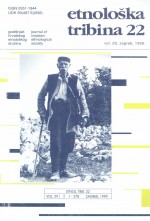Pavenka — djevojačka večer i pletenje svadbenog vijenca
Pavenka — Girls Farewell Evening and Weaving the Wedding Wreath
Author(s): Nevena ŠkrbićContributor(s): Snježana Ivanović (Translator)
Subject(s): Gender Studies, Customs / Folklore, Cultural Anthropology / Ethnology
Published by: Hrvatsko etnološko društvo
Keywords: wedding customs; wedding wreath — pavenka; Lika;
Summary/Abstract: Starting point for the research of this topic is the prominent place that the plant pavenka has in wedding customs of Lika and its use in making the bride’s wedding wreath. The author in the article analyses the appearance and preparations of bride’s wedding wreath of pavenka, its symbolic meaning, the meaning of the term pavenka and vinac, as well as other wedding decorations made of pavenka. She particularly reviews the customs and participants in the girls evening, and singles out some interesting elements of customs and beliefs related to the wedding wreath. In the final part of the article she points to the changes of the basic pattern of the girls evening as well as to the gradual changes of the wedding decorations and the role of pavenka in wedding customs today. Among the details of this important custom from Lika old Slavic elements could be discerned. The weaving of the wedding wreath was the important custom with different Slavic peoples. Comparing the weaving of the wreath in Lika and the description of the customs with other Slavs according to M. Gavazzi, certain correspondences are noticeable. Thus, the wreath with other Slavs as well was woven of one or two special plants mainly evergreen. The meeting at which it was woven was bride’s farewell evening and was held usually the evening before the wedding, most often in the bride’s house, which is the case in Lika. With other Slavs the term for the wreath meant the meeting itself; the bride is assisted in weaving the wreath by her single friends, taking the plants from sieve or coarse sieve; this procedure is also accompanied by singing of the girls quire, and the lirics of the song is related to the bride’s weaving of the wreath and the departure from her family; the sequence of the singing is the same as in Lika: first it is sung to the father, then to the mother (or vice versa), then to the brother, sister and other relatives, and in the end everywhere to the bridegroom. The appearance of a hollow cake at that meeting in Ukraine is very interesting. The wreath is put into a cake that has the shape of a wheel and it is carried to the bride’s parents so that they can by it bless the wedding of their daughter, which to some extent corresponds to the description of parents’ blessing in Pazarišta. Thus, the custom of the girls farewell evening and weaving the wedding wreath from evergreen plants, according to numerous indicators is the remnant of the old Slavic custom, whose elements are best preserved in Lika out of all Croatian regions.
Journal: Etnološka tribina : Godišnjak Hrvatskog etnološkog društva
- Issue Year: 29/1999
- Issue No: 22
- Page Range: 107-131
- Page Count: 25
- Language: Croatian

